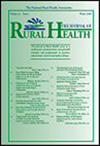The influence of rurality on self-reported physical therapy utilization among patients with severe chronic back pain in the United States
Abstract
Purpose
To examine the association of rurality and physical therapy utilization among a nationally representative sample of individuals with severe chronic back pain.
Methods
This study utilized a publicly available dataset from the 2019 National Health Information Survey (Adult Sample). Individuals with severe chronic back pain were identified based on survey items examining respondents’ pain frequency and location. Physical therapy utilization was identified based on survey questions asking about pain management strategies utilized over the previous 3 months. Rurality was classified as large central metro, large fringe metro, medium and small metro, and nonmetropolitan/rural, based on the county of residence. Regression was used to examine the association between rurality and physical therapy utilization, while controlling for relevant covariates. National estimates were calculated using provided weighting variables.
Results
We identified 2925 individuals (weighted = 20,468,134) meeting the criteria for severe chronic back pain. We observed that individuals with severe chronic back pain living in nonmetropolitan/rural areas had 34% lower odds of (weighted OR: 0.66, 95% CI: 0.47, 0.92) utilizing physical therapy compared to individuals living in large central metropolitan areas. We did not observe significant differences in the odds of utilizing physical therapy among individuals living in large fringe metropolitan areas or medium–small metropolitan areas.
Conclusions
Individuals living in rural parts of the United States have lower odds of using physical therapy for management of their severe chronic back pain. Additional research is needed to examine the factors that contribute to these differences and improve access to care.

 求助内容:
求助内容: 应助结果提醒方式:
应助结果提醒方式:


